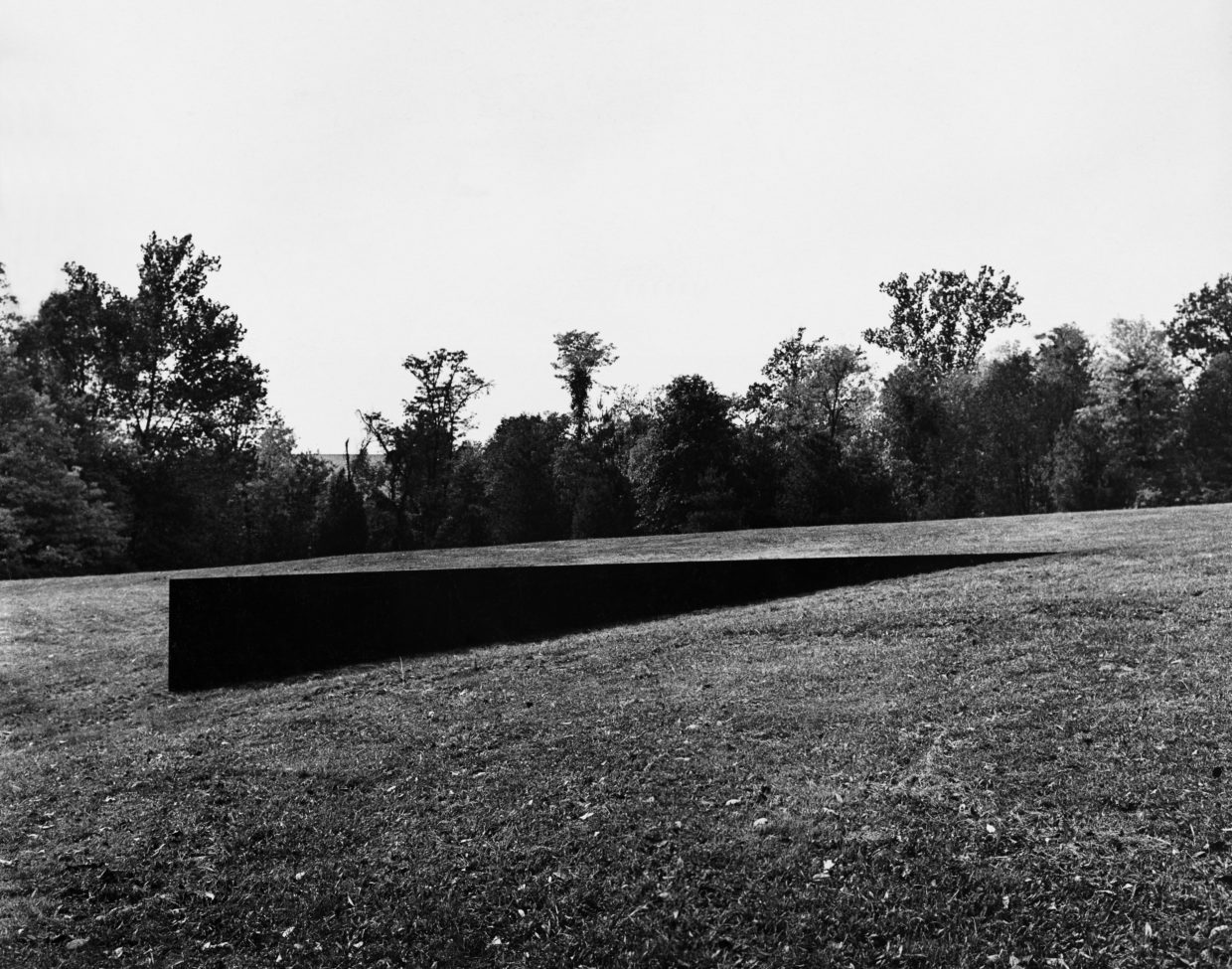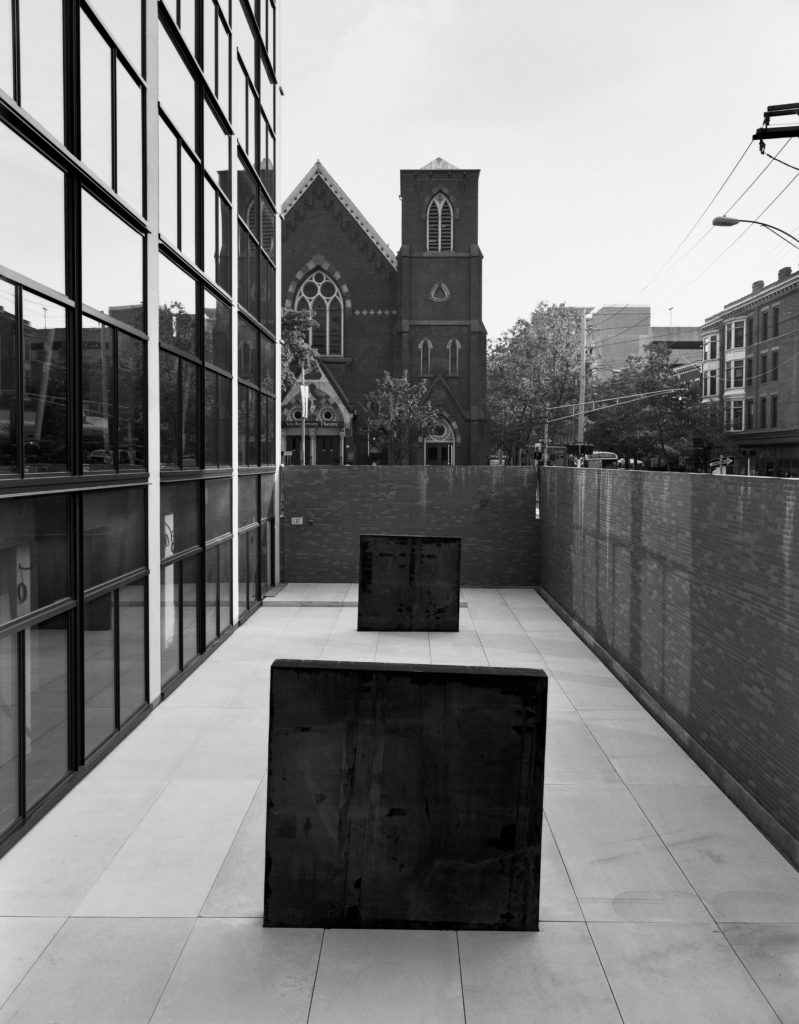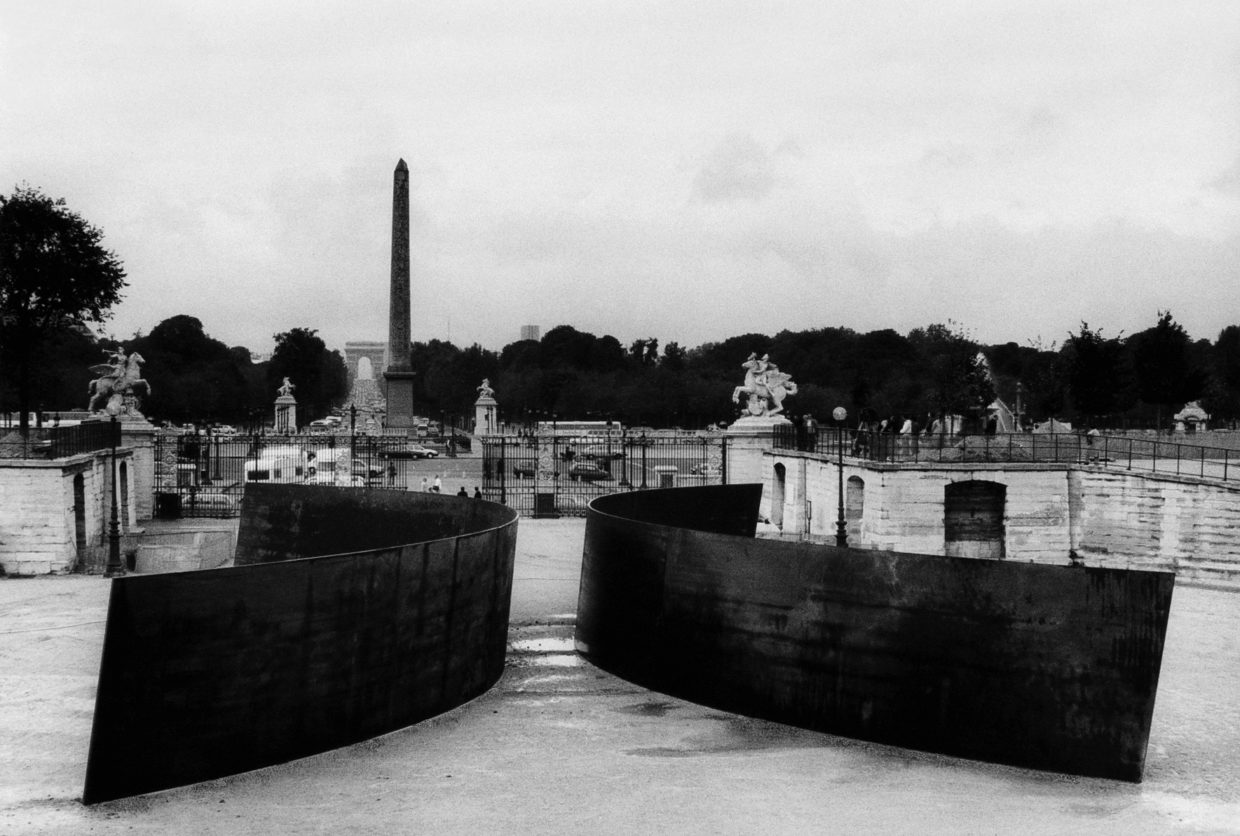
How Do You Make Art From Walking and Looking?
Hal Foster Talks to Richard Serra About Sites, Non-Sites, and Mobile Bodies
The following conversation about sculpture is from… Conversations About Sculpture, with Hal Foster and Richard Serra.
*
Hal Foster: Was there an internal necessity, once you pulled your sculpture up in the prop pieces, to pull it apart as well?
Richard Serra: Not at first. When I lifted the plates off the ground, I realized it was also a limitation, and that there was a need to separate them, but at the time I didn’t know how. The move into space happened with Strike (1969–71). Strike cut, divided, and declared the room as context.
HF: Is this where your trip to Japan in 1970 and your encounter with Zen gardens comes into play?
RS: No. The small lead plate I shoved into the corner when I was working on Splash Piece: Casting for [Jasper] Johns was the origin of Strike, but the experience of the Japanese gardens was enormously important for my first landscape pieces. The gardens opened up a perceptual world; they made me rethink the undifferentiated field of Pollock and the writings of Anton Ehrenzweig. What is essential is the time of experiencing the gardens as you move through them: it’s a physical time. Time is compressed or protracted, but it’s always articulated. Perception narrows to details, but always returns to the field in its entirety.
HF: How did you process your experience in Japan? Clearly your work was headed in that direction; you were also looking at the first earthworks—Michael Heizer’s Double Negative (1969–70) and Robert Smithson’s Spiral Jetty (1970). How did all these different interests come together to make for your specific intervention into space—opening up a sculptural field and delineating it with the body moving in time?
RS: The most consequential move into the landscape was Pulitzer Piece: Stepped Elevation (1970–71), followed by Shift (1970–72) and Spin Out (for Bob Smithson) (1972–73). They were all crucial for me because they took concerns I had worked out in interior spaces and tested them in exterior settings. Pulitzer Piece was my first big step into the landscape. That was after going to Japan, which changed my way of seeing space in relation to time. The stakes were very high. I was up against the Pulitzer collection—Monet, Matisse, Picasso, you name it. It took a couple of years to finish.
 Spin Out (For Bob Smithson), 1972–73. Weatherproof steel, three plates, each 10 ft. × 40 ft. × 1 1/2 in. (3 m × 12.2 m × 3.8 cm). Kröller-Müller Museum, Otterlo, The Netherlands.
Spin Out (For Bob Smithson), 1972–73. Weatherproof steel, three plates, each 10 ft. × 40 ft. × 1 1/2 in. (3 m × 12.2 m × 3.8 cm). Kröller-Müller Museum, Otterlo, The Netherlands.
HF: What was the next moment in the development of your ideas about site?
RS: When Heizer and Smithson began doing earthworks, they asked me to join them. I was interested in their work, but it wasn’t for me. I saw Heizer as extending Judd’s volumes into the landscape, and I saw Smithson as dealing with his own peculiar iconography of geology, crystallography, and all the rest. I helped him lay out Spiral Jetty, and after he died I worked with others to finish Amarillo Ramp (1973).
HF: In an early text, “Play It Again, Sam” (1970), you’re skeptical of scatter installations (despite doing a few yourself); you call them a “lateral spread of materials” on the floor. Your complaint is that they reinscribe a “landscape mode,” one that doesn’t avoid “arrangement qua figure ground: the pictorial convention.” Further, you say, “Lateral extension in this case allows sculpture to be viewed pictorially—that is, as if the floor were the canvas plane. It is no coincidence that most earthworks are photographed from the air.”
RS: Yes, for the most part earthworks are graphic ideas imposed on the landscape. I was interested in a different penetration into the land, one that would open up the field and bring you into it bodily through movement, not just draw you in visually. The rhythm of the body moving through space has been the motivating source of most of my work.
HF: In a conversation a decade later you talk about how earthworks came to the public mostly in the form of documents: “I have never found that satisfying. I would rather have the actual experience of work at urban scale.” You also assert that photographs destroy the “temporal experience” of earthworks, that the photos become a way to consume them.
RS: It’s a virtual market device. I saw that early on and didn’t want any part of it.
HF: Did that aversion lead to any testy exchanges with Smithson or Heizer as to the limits of documentation or indeed of the site/non-site idea?
RS: No. Artists have their own ways of doing things, and you can’t be putting them down. I see documentation as an attribute, just as I see language as an attribute. The non-sites ended up being a road show, without commitment to any specific place. The concept of the non-site is a theoretical justification for homeless objects.
HF: You see them as secondary.
RS: Yes. They are artifices that lead you in other directions. A photograph of an earthwork reduces it, flattens it, frames it. It changes its color, takes away its tactility, has nothing to do with its three-dimensionality, nothing to do with its context, nothing to do with its space. It’s virtual reality.
HF: So you were never interested in how the non-site idea could render the work of art textual and so open it up to other forms, formats, sources, and meanings.
RS: I thought that textuality was a departure from the physical realities of the world we live in. I had the same problem with some of the “Pictures” artists.
HF: “Pictures” artists like Cindy Sherman and Louise Lawler showed us how mass media have transformed the world we live in. That was their intention, and their textualization of the art work helped them realize it. They turned what was a problem for you into an advantage for them. But back to your site pieces.
 Pulitzer Piece: Stepped Elevation, 1970–71 (detail). Weatherproof steel; three plates, 60 in. × 40 ft. 3 in. × 2 in. (152.4 cm × 12.3 m × 5 cm), 60 in. × 45 ft. 11 in. × 2 in. (152.4 cm × 14 m × 5 cm), 60 in. × 50 ft. 7 in. × 2 in. (152.4 cm × 15.4 m × 5 cm). Pulitzer Residence, Saint Louis. Emily Rauh Pulitzer. Photo Shunk-Kender. © Roy Lichtenstein Foundation.
Pulitzer Piece: Stepped Elevation, 1970–71 (detail). Weatherproof steel; three plates, 60 in. × 40 ft. 3 in. × 2 in. (152.4 cm × 12.3 m × 5 cm), 60 in. × 45 ft. 11 in. × 2 in. (152.4 cm × 14 m × 5 cm), 60 in. × 50 ft. 7 in. × 2 in. (152.4 cm × 15.4 m × 5 cm). Pulitzer Residence, Saint Louis. Emily Rauh Pulitzer. Photo Shunk-Kender. © Roy Lichtenstein Foundation.
RS: I didn’t want to make a sign or a symbol in the landscape as earthworks do; I wanted to work with its topography. How do you make walking and looking the content of your work? What happens to your body when the elevation is constantly shifting and there’s no horizon to orient you, no flat plane? How do you cut into the land, gather it in a volume, and hold that volume?
HF: That interest has persisted, and you’ve developed a language to articulate those volumes in different sites. Yet already in 1980, even as you continued with landscape projects, you said you preferred urban settings. What do the two kinds of intervention share, and how do they diverge? Also in 1980 you remarked, “In the landscape pieces the redefinition of the site becomes the content of the work.” Isn’t that true of your urban pieces as well?
RS: Take Splashing, the first lead splash at the Castelli warehouse: not only is it built into the space directly, but it changes the architecture totally.
HF: I understand that’s your initial instance of site-specificity, but it’s interior and architectural. My question is about sites that are exterior and urban.
RS: Urban sites are much more difficult. You have more contingencies with more attributes, and you must push back with your own sculptural invention against a host of narratives, many of which are ideological. You have to gather the volumes that are already there, the circulation patterns, whatever, in fact all that goes into how the site is defined and perceived. I want to reclaim the site for sculpture.
HF: Is there more gathering to do in the urban pieces than in the landscape pieces?
RS: Landscape sites are easier for me to deal with because there’s less interference.
Clara Weyergraf-Serra: What do you mean by “gathering”?
HF: I think it has to do with the way a piece picks up on aspects of its surroundings and pulls them into itself as part of its content. Do you feel more compelled to do this gathering in the urban sites with all their contingencies?
RS: You’re presented with different kinds of sites, and you have to work with what’s given in those sites. Landscape sites are easier to work with than urban sites for the reasons I just mentioned.
HF: What other similarities and dissimilarities obtain in the two types of site? At least initially, most of your landscape projects favored a horizontal extension across a site, as in a cut, while most of your city projects privileged a vertical marking of a site, as with a tower. The early urban arcs, such as St. John’s Rotary Arc (1980) and Tilted Arc (1981), both in lower Manhattan, were obvious exceptions, but they were positioned in particular spaces—a “leftover site” (as you called it) in the first instance, the exit of the Holland Tunnel, and a plaza space in the second, near the courthouses—which they marked in distinctive ways. Maybe your arcs mediate between the horizontal landscape pieces and the vertical urban ones. How do you decide, then, when to propose, in an urban context, a tower like Sight Point (1972–75) or an arc like St. John’s Rotary Arc?
RS: Again, for the most part the sites are given; you don’t choose them, though with Sight Point, which is at the Stedelijk in Amsterdam, I was able to select the site, and I decided to build a tower.
 Sight Point, 1972–75. Weatherproof steel, three plates, each 40 ft. × 10 ft. × 2 1/2 in. (12.2 m × 3 m × 6.4 cm). Stedelijk Museum, Amsterdam, The Netherlands. Reinstallation in 2012 supported by Irene and Rijkman Groenink. Photo Lorenz Kienzle
Sight Point, 1972–75. Weatherproof steel, three plates, each 40 ft. × 10 ft. × 2 1/2 in. (12.2 m × 3 m × 6.4 cm). Stedelijk Museum, Amsterdam, The Netherlands. Reinstallation in 2012 supported by Irene and Rijkman Groenink. Photo Lorenz Kienzle
HF: It sounds as though the distinctions are not hard and fast, that some aspects of the landscape pieces can be carried over to the urban pieces and vice versa.
RS: I haven’t found a seamless way of moving from one to the other. Actually, I don’t think it can be seamless, and maybe it shouldn’t be.
HF: A commonality between the two types of work is that both are opposed to gestalt readings.
RS: That’s true. The gestalt is a great limitation, a pictorial limitation: the viewer can complete the image of an object by looking at one part only. Most Minimalists are stuck with gestalt readings. They don’t truly open the space; for the most part their constructions remain objects.
HF: The resistance to gestalt readings is already present in your early work. It was important to you to carry forward that critique in your sited works?
RS: Yes, absolutely.
HF: Let me point to another distinction between the two types, an opposition even, and ask if it still holds. In 1983 you said, “In the landscape, even if I go through the same process of site analysis, the sculptures have more to do with movement than with location. The landscape pieces are usually open, the urban pieces generally closed. . . . You enter in the structure, which is a space that breaks with the surroundings.” Does this open-closed binary still obtain?
RS: That statement is mostly about the towers.
HF: So the arcs do have more in common with the landscape pieces, and you can use that part of your landscape language in the city if the site allowed it. Which do permit it?
RS: Plazas, traffic rotaries, and university campuses, to name a few.
HF: Like the serpentine piece at Princeton, The Hedgehog and the Fox (1998).
RS: Yes, but then there’s the piece at Yale, Stacks (1990), which is neither an arc nor a serpentine. It was moved from an interior site and repositioned in a courtyard fronting the museum. It’s open like a landscape piece, but it also reads vertically. Its two plates are centered on each other and set a good distance apart, each one tilted into the ground. Stacks is another piece that breaks with the landscape-urban opposition.
 Stacks, 1990. Hot-rolled steel, two slabs, each 8 ft. × 8 ft. × 10 in. (2.4 m × 2.4 m × 25.4 cm). Yale University Art Gallery, New Haven. Katherine Ordway Fund. Photo Lorenz Kienzle
Stacks, 1990. Hot-rolled steel, two slabs, each 8 ft. × 8 ft. × 10 in. (2.4 m × 2.4 m × 25.4 cm). Yale University Art Gallery, New Haven. Katherine Ordway Fund. Photo Lorenz Kienzle
HF: What about the opposition between open and closed structures you noted in 1983?
RS: Well, up to that point that was probably true.
HF: So you began with certain oppositions, such as horizontal-vertical and open-closed, and you moved to complicate them.
CW-S: Where would you place Clara-Clara (1983)?
RS: Typologically speaking, Clara-Clara is a landscape piece.
HF: It’s in a pretty famous urban setting! But then the park mediates between the landscape and the city.
CW-S: I think Clara-Clara is an urban piece through and through.
 Clara-Clara, 1983. Weatherproof steel, two near-identical conical sections inverted relative to each other, 12 ft. × 109 ft. × 2 in. (3.7 m × 33.2 m × 5 cm), 12 ft. × 107 ft. 10 in. × 2 in. (3.7 m × 32.8 m × 5 cm). Collection City of Paris. Photo Dirk Reinartz
Clara-Clara, 1983. Weatherproof steel, two near-identical conical sections inverted relative to each other, 12 ft. × 109 ft. × 2 in. (3.7 m × 33.2 m × 5 cm), 12 ft. × 107 ft. 10 in. × 2 in. (3.7 m × 32.8 m × 5 cm). Collection City of Paris. Photo Dirk Reinartz
HF: Certainly it wants to be in that particular setting. I identify it with the Tuileries axis so much that I imagine it there to this day. It might be another instance of a work that is both-and. There’s a further distinction between your landscape and urban pieces: you talk about “redefinition” in relation to the former and “contradiction,” even “subversion,” in relation to the latter. Does that difference still hold?
RS: I think so. When you’re in an urban setting, you’re up against your surroundings, the architecture above all, most of which is mediocre or worse. You can’t avoid it; you have to acknowledge it.
__________________________________

From Conversations about Sculpture by Richard Serra and Hal Foster; published by Yale University Press in November 2018. Reproduced by permission.
Hal Foster and Richard Serra
Richard Serra is an internationally renowned artist, best known for steel sculptures that engage audiences through material, form, structure, and site specificity. He has exhibited widely since his first solo exhibition in 1966 and has work publicly sited in Amsterdam, London, San Francisco, Bilbao, Berlin, Qatar, and elsewhere. Serra has been awarded the title of Chevalier de l’Ordre national de la Legion d’honneur and the J. Paul Getty Medal, among many other honors.
Hal Foster is Townsend Martin, Class of 1917, Professor of Art and Archaeology at Princeton University. An award-winning author, his publications include Bad New Days, The Art-Architecture Complex, and The Return of the Real.



















